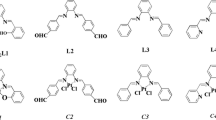Abstract
The [PtCl2(LL)] complex, as a cisplatin derivative, which LL is diamine chelate ligand (N,N-dimethyltrimethylendiamine), was synthesized and characterized by elemental analysis (CHN) mass, 1H, and 13C nuclear magnetic resonance techniques. Then the binding of this complex to calf thymus DNA was investigated by various physicochemical methods such as spectrophotometric, circular dichroism, spectrofluorometric, melting temperature, and viscosimetric techniques. Upon addition of the complex, important changes were observed in the characteristic UV–Vis bands (hypochromism) of calf thymus DNA, increase in melting temperature and some changes in specific viscosity. Also, the fluorescence spectral characteristics showed an increase in the fluorescence intensity of methylene blue–DNA solutions in the presence of increasing amounts of metal complex, indicating PtCl2(LL) is able to displace the methylene blue bound to DNA but not as complete as intercalative molecules. The experimental results showed that the platinum complex is bound to DNA non-intercalatively, and an outside binding is the preferred mode of interaction.







Similar content being viewed by others
References
Nan, L., Ying, M., Cheng, Y., Liping, G., & Xiurong, Y. (2005). Biophysical Chemistry, 116, 199–205. doi:10.1016/j.bpc.2005.04.009.
Kostova, I. (2006). Platinum complexes as anticancer agents. Recent Patents on Anti-cancer Drug Discovery, 1, 1–22. doi:10.2174/157489206775246458.
Gay, M., Montana, A. M., Moreno, M., Prieto, M. J., Perez, J. M., & Alonso, C. (2006). Bioorganic & Medicinal Chemistry, 14, 1565–1572. doi:10.1016/j.bmc.2005.10.016.
Liu, X., Li, J., Li, H., Zheng, K.-C., Chao, H., & Ji, L.-N. (2005). Journal of Inorganic Biochemistry, 99, 2372–2380. doi:10.1016/j.jinorgbio.2005.09.004.
Messori, L., Marcon, G., Innocenti, A., Gallori, E., Franchi, M., & Orioli, P. (2005). Bioinorganic Chemistry and Applications, 3, 239–253. doi:10.1155/BCA.2005.239.
Sherman, S. E., & Lippard, S. J. (1987). Chemical Reviews, 87, 1153–1181. doi:10.1021/cr00081a013.
Freifelder, D. (1976). Physical biochemistry, part two (pp. 124–125). SanFrancisco: W. H. Freeman and Company.
Sambrook, J., Fritsche, E. F., & Maniatis, T. (1989). Molecular cloning: A laboratory manual. Cold Spring Harbor, NY: Cold Spring Harbor Laboratory.
Mahadevan, S., & Palaniandavar, M. (1998). Inorganic Chemistry, 37, 693–700. doi:10.1021/ic961066r.
Vijayalakshmi, R., Kanthimathi, M., Subramanian, V., & Unni Nair, B. (2000). Biochimica et Biophysica Acta, 1475, 157–162.
Yang, P., & Guo, M. (1999). Coordination Chemistry Reviews, 185–186, 189–211. doi:10.1016/S0010-8545(98)00268-9.
Cervantes, G., Prieto, M. J., & Moreno, V. (1997). Metal-Based Drugs, 4, 9–18. doi:10.1155/MBD.1997.9.
Rau, T. Van Eldik, V. (1996) A. Sigel, H. Sigel (Eds.), Metal ions in biological systems, vol. 32, Marcel Dekker, New York, pp.340–373.
Lawrence, D., & Vaidyanathan, V. G. (2006). Journal of Inorganic Biochemistry, 100, 1244–1251. doi:10.1016/j.jinorgbio.2006.02.003.
Kashanian, S., Gholivand, M. B., Ahmadi, F., Taravati, A., & Hosseinzadeh Colagar, A. (2006). Spectrochimica Acta Part A, 67, 427–478.
Ramakrishnan, S., & Palaniandavar, M. (2005). Journal of Chemical Sciences, 17, 179–186.
Mahadevan, S., & Palaniandavar, M. (1997). Inorganica Chimica Acta, 254, 291–302. doi:10.1016/S0020-1693(96)05175-4.
Routier, S., Bernier, J. L., Waring, M. J., Colson, P., Houssier, C., & Bailly, C. (1996). The Journal of Organic Chemistry, 61, 2326–2331. doi:10.1021/jo951840c.
Fasman, G. D. (1996). Circular dichroism and conformational analysis of biomolecules (pp. 433–465). New York: Plenum Press.
Kang, J., Wu, H., Lu, X., Wang, Y., & Zhou, L. (2005). Spectrochimica Acta Part A, 61, 2041–2047. doi:10.1016/j.saa.2004.08.009.
Liu, F., Meadows, K. A., & McMillinn, D. R. (1993). Journal of the American Chemical Society, 115, 6699–6704. doi:10.1021/ja00068a029.
Wainwright, M., & Giddens, R. M. (2003). Dyes and Pigments, 57, 245–257. doi:10.1016/S0143-7208(03)00021-4.
Tuite, E., & Nordén, B. (1994). Journal of the American Chemical Society, 116, 1548–7556. doi:10.1021/ja00096a011.
Fujimoto, B. S., Clendenning, J. B., Delrow, J. J., Heath, P. J., & Schurr, M. (1994). Journal of Physical Chemistry, 98, 6633–6643. doi:10.1021/j100077a033.
Appleton, T. G., & Hall, J. R. (1970). Inorganic Chemistry, 9, 1807–1813. doi:10.1021/ic50090a006.
Author information
Authors and Affiliations
Corresponding authors
Rights and permissions
About this article
Cite this article
Shahabadi, N., Kashanian, S., Shalmashi, K. et al. DNA Interaction with PtCl2(LL) (LL = Chelating Diamine Ligand: N,N-Dimethyltrimethylendiamine) Complex. Appl Biochem Biotechnol 158, 1–10 (2009). https://doi.org/10.1007/s12010-009-8680-2
Received:
Accepted:
Published:
Issue Date:
DOI: https://doi.org/10.1007/s12010-009-8680-2




